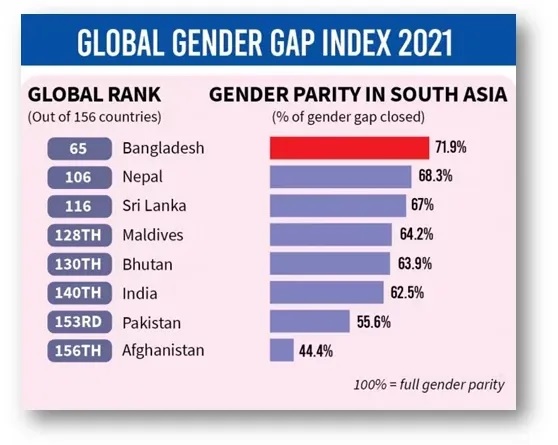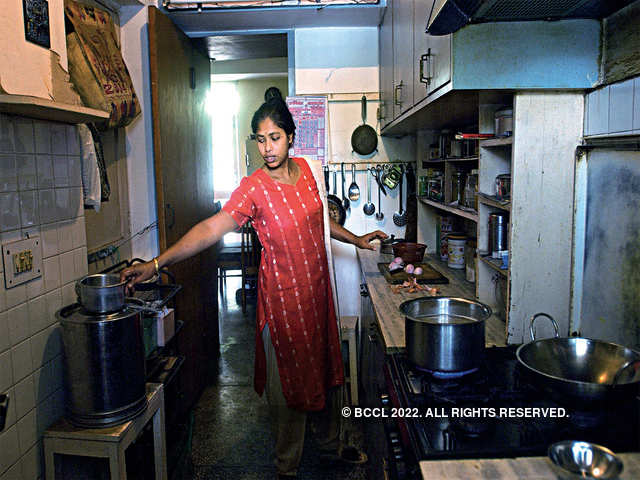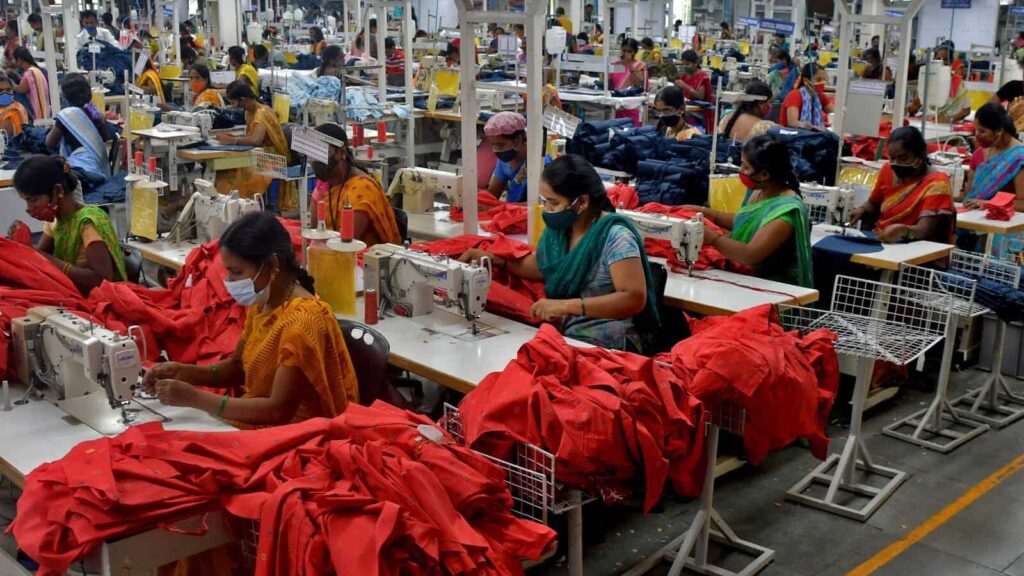Under the watchful eyes of the market, International Women’s Day has been turned into a consumer driven festival. The grand events organized on this occasion by the governments and corporates who have an opposite perspective to the basic spirit behind the celebration of this day, many a times generate anger.
International Women’s Day was recognized by the United Nations in 1975. The theme of the 2022 International Women’s Day is ‘Gender Equality Today for a Sustainable Tomorrow’, but gender equality seems like an impossible dream in India.

The World Economic Forum’s Gender Gap Report 2021, based on women’s participation in economic opportunities, politics, education and health, points to the increasingly pathetic condition of women in India. India’s rank has fallen further down by 28 steps, come down to rank 140 out of 156 countries. Covid seems to be responsible for this decline.
It is a known fact that war and epidemics hit the vulnerable sections the most, such as women. The LinkedIn Opportunity Index shows that the negative impact of COVID-19 on Indian women was greater than for women in the rest of the world. They faced the most gender discrimination among the Asia Pacific countries and were seen fighting for equal pay and equal opportunities.
The World Gender Gap Report 2021 says that if the situation remains the same, it will take 135.6 years for the world to achieve the goal of gender equality. It is scary to even imagine how long it will take for India to reach that goal.

The early history of International Women’s Day is directly linked to working women and workers when the streets of New York witnessed a protest of 15,000 women on March 8, 1908. Their demands were for reduced working hours and increase in wages. Despite the long journey of International Women’s Day, women’s labor has not been accepted and respected.
It is the natural tendency of the male centric economy to consider female labor as lowly, insignificant and negligible. According to NFHS 5 (National Family Health Survey-5) , only 25.4 percent of working women aged 15-49 have received cash payments in the last 12 months.
State of Working Women in India
According to Oxfam’s 2019 “Mind the Gap: State of Employment in India” report, Indian women collectively work 1,640 million hours a day for which they get nothing. OECD data says that Indian men spend only 56 minutes a day in domestic work while women spend 353 minutes a day. The Time Use Survey 2019 of the Government of India shows that 92 percent of working age women on an average spend five hours and fifteen minutes a day in household chores. Experts estimate the value of domestic labor of 350 million domestic women to be $613 billion. The striking thing in these figures is that a man whether illiterate or highly educated, stays away from domestic work but a highly educated woman is burdened with domestic work as much as an illiterate woman.

Some recent surveys show that the position of Indian women has improved a bit on several parameters. According to the NSS (75th Round, July 2017–June 2018), India’s female literacy rate is now 70 percent. The Government of India’s All India Survey on Higher Education 2019-20 says that women’s enrollment in higher education is also reaching the same level as men and the number of women enrolling in higher education is now 39%. But it is also notable that the presence of women in medical and engineering education is negligible.
The NFHS 5 figures also indicate a better position of women in certain areas. According to NFHS-4, the percentage of married Indian women involved in important family decisions was 84 percent, it is now 88.7 percent. According to NFHS-4, 45.9 percent of women had a mobile phone, which has now increased to 54 percent, while the number of women who have bank accounts has increased from 53 percent in NFHS-4 to 78.6 percent.
Though small, but improvements in all these parameters does not show the effect of increasing economic-socio-political power of women, it needs to be investigated.
If the NSSO and Periodic Labor Force surveys of the last few years are to be analysed, we can see that there is a sharp decline in the presence of women in the labor force during the last three decades. The share of women in the workforce was 41 per cent in 1999-2000 which declined to 32 per cent in 2011-12 and is 20.3 per cent as per the 2019 data. For Bangladesh and Sri Lanka these figures are 30.5 and 33.7 percent respectively. According to a 2018 McKinsey report, a 10% increase in the number of women in the workforce could add $770 billion to our GDP.
For Laborers – Especially Women and Youth – Things are Only Getting Worse Under Neoliberalism
There are many explanations for this decline. Advocates of the neoliberal economy believe that it is a sign of economic prosperity. The income of the men in the family has increased, due to which women do not need to go to work. Surveys by the Economic and Political Weekly and some other organizations show that if the income of men in the family is decent, then about 40 percent of both men and women want women to stay at home. Such explanation is completely unacceptable amidst rampant poverty, hunger, rising unemployment and falling wages.
The decline in labor participation rate can be explained in simple words. 80 percent of women of working age in India are engaged in domestic and other unpaid work without earning a living.

Agriculture was the biggest source of employment for women, but privatization of agriculture has encouraged mechanization and the need for human labor has decreased. Employment opportunities for both men and women in agriculture have decreased. Men have become migrant laborers by migrating to small and medium cities and metros, women have remained in villages. A large number of cheap male workers are posing a challenge to women and they are getting preference over women in jobs considered reserved for women. After agriculture, the textile and readymade garments industry is the second job giver for women, where 75 percent of the 4.5 crore workforce is women, but even here the entry of big players has led to reduced employment. Many tasks are reserved for men by law and were traditionally women are not even considered to be given opportunities.
The National Council of Applied Economy Research estimates that 97 percent of women workers in India are employed in the unorganized or informal sector. According to the experts of International Labour Organisation, the biggest drawback of the policies made for the unorganized sector is that data related to the number of women working in different sectors is not collected before policy formulation. While discussing the official statistics for the declining number of women workers, it should also be noted that the sectors which have the highest number of women workers are not part of these numbers. If only domestic work figures are included in this, then the labor force participation of women will be 81 percent.
Equal wages, social security, maternity leave, maternity benefits and protection from sexual exploitation are just a dream for women working in the unorganized sector. Our Justice and legal system is deeply patriarchal. Even some of the laws that are made in favour of women, their implementation is hindered by the male dominated system and makes these laws effective.

According to studies, our labor market gives women only half the cost of their labor as compared to men. Even at the supervisory level in the private sector, women are paid 20 per cent less than their male counterparts.
The Maternity Benefit (Amendment) Act, 2017 has made provision for 26 weeks of paid maternity leave along with mandatory creche facility. As a result, it was seen that private sector employers refrained from hiring women and created conditions for pregnant women to quit. In November 2018, government also announced that it would pay the wages of the 7 weeks of maternity leave to the companies. But the fact remains that every year about three crore women become pregnant but the benefit of this law is only for one lakh women.
Sexual harassment at Workplace
A survey by Human Rights Watch (October 2020) discusses limited government efforts to enforce sexual harassment laws in informal sector. The survey specifically mentions that women in the informal sector and the women workforce engaged in the implementation of government welfare programs are more likely to be ignored. The survey conducted by the Indian National Bar Association in 2017 also comes up with similar findings. According to this there is sexual harassment in various sectors of employment. Most of the women do not report harassment due to stigma, fear of retaliation, shame, lack of awareness about reporting policies or distrust in the redressal mechanism.

There has not been any authentic study about sexual harassment, nor are there any official data about it. Women do not discuss it in family out of fear. Fear being that in most cases the family would make them quit job itself. of the cases the family loses the job. It is also difficult to tell what percentage of women quit their job due to sexual harassment.
According to the International Institute of Population Sciences (Nodal Agency, NFH4) and ICF, USA, working women in India are more likely to face physical violence. Non-working women make up 26 percent of those who have faced physical violence, while 40 percent of working women have faced physical violence.
A myth is being spread that the neoliberal economy will lead to economic emancipation of women while the truth is that it has led to shrinking of the organized sector and the exploitative nature of the unorganized sector is openly embraced.
The contract system and the practice of contractual appointment have increased and women have become easy prey. Naive and unorganized women are hired for low wages and fired at will. Randstad’s Gender Perception Survey 2019 shows that 63 percent of women have either faced gender discrimination while hiring in the private sector or know a woman who has been subjected to gender discrimination during employment. This discrimination is also seen in increment and promotion.

Only 20 percent of the enterprises in our country are owned by women. Only 6 percent of women are the founders of Indian startups. Startups with female founders could receive only 1.43 per cent of the gross investor funding. 69 percent of women believe that cultural and personal barriers make their journey as an entrepreneur difficult. According to one analysis, the number of female leaders in industries is less than half that of men.
One of the reasons the path to gender equality in India is difficult because of less women representation in politics. Secondly, the women who are at top political positions in politics follow the same masculine outlook when in power. Only 14 per cent of the current parliament is women. Some of them hold senior positions in the central government, but they also seem to support the ideology that dreams of replacing our Constitution with Manusmriti. The same manusmriti according to which women need to be under the control of father in childhood, husband in adulthood and sons in old age.
Dr. Raju Pandey is a Gandhian writer and thinker. He lives in Raigarh. Views are personal. The article was first published in junputh. It is translated into English by Dr. Swati.



